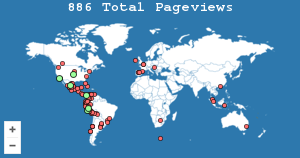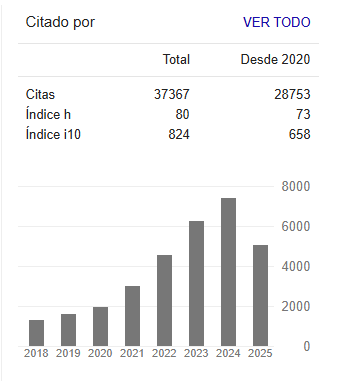eWOM, confianza y engagement: incidencia en el capital de marca
Abstract
Esta investigación tiene por objetivo determinar la influencia de las comunicaciones a través de las redes sociales virtuales (RSV), la confianza y el engagement, sobre el capital de marca (BE). Se aplicó un cuestionario estructurado a una muestra de 382 clientes de zapatillas deportivas en el mercado ecuatoriano. Las relaciones hipotetizadas se testaron a través de un modelo de ecuaciones estructurales (SEM) utilizando el software estadístico SmartPLS. El estudio empírico confirmó que tanto el e-WOM recibido por los individuos como la confianza, inciden significativamente sobre el capital de marca; sin embargo, la relación entre el engagement y el capital de marca no pudo confirmarse. Se concluye que mientras más consumidores difundan sus experiencias positivas con las marcas, en contextos virtuales, mejor será la percepción de esas marcas en la mente de los consumidores. Confirmándose un impacto positivo del boca oído-electrónica sobre la confianza y el capital de marca.References
Aaker, D. (1991). Managing Brand Equity. Journal of Marketing, 56(2), 125. https://doi.org/10.2307/1252048
Aaker, D. y Alvarez del Blanco, R. (1994). Gestión del valor de la marca, capitalizar el valor de la marca. Ediciones, Madrid.
Ali Khadim, R., Ahmad, M., Arshad, A., Saleem, N. y Ali Khadim, N. (2018). Revisiting antecedents of brand loyalty: Impact of perceived social media Communication with brand trust and brand Equity as mediators. Academy of Strategic Management Journal, 17(1).
Asociación para la investigación de medios de comunicación AIMC (2018). Principales resultados uso de las redes sociales en la compra. AIMC, 1–7.
Aziz El Naggar, R. y Bendary, N. (2017), The Impact of Experience and Brand trust on Brand loyalty , while considering the mediating effect of brand Equity dimensions, an empirical study on mobile operator subscribers in Egypt. The Business and Management Review, 9(2), 16–25.
Babić, A., Sotgiu, F., De Valck, K. y Bijmolt, T. (2016), The Effect of Electronic Word of Mouth on Sales: A Meta-Analytic Review of Platform, Product, and Metric Factors. Journal of Marketing Research, 53(3), 297–318. https://doi.org/10.1509/jmr.14.0380
Bagozzi, R. y Yi, Y. (1998). On the Evaluation of Structural Equation Models, Journal of the Academy of Marketing Science, 16(1), 074–094.
Bhandari, M. y Rodgers, S. (2018). What does the brand say ? Effects of brand feedback to negative eWOM on brand trust and purchase intentions, International Journal of Advertising, 37(1), 125–141. https://doi.org/10.1080/02650487.2017.1349030
Bowden, L. (2009). The process of customer engagement: A Conceptual Framework. The Journal of Marketing Theory and Practice, 17(1), 63–74. https://doi.org/10.2753/MTP1069-6679170105
Brodie, R., Ilic, A., Juric, B. y Hollebeek, L. (2013), Consumer engagement in a virtual brand community: An exploratory analysis. Journal of Business Research, 66(1), 105–114. https://doi.org/10.1016/j.jbusres.2011.07.029
Buil, I., Martínez, E. y De Chernatony, L. (2010). Medición del valor de marca desde un enfoque formativo. Cuadernos de Gestion, 109(núm. especial), 167–196. https://doi.org/10.5295/cdg.100204ib
Chahal, H. y Rani, A. (2017). How trust moderates social media engagement and brand equity. Journal of Research in Interactive Marketing, 11(3), 312–335. https://doi.org/10.1108/JRIM-10-2016-0104
Chahal, H. y Bala, M. (2010). Confirmatory Study on Brand Equity and Brand Loyalty: A Special Look at the Impact of Attitudinal and Behavioural Loyalty. Vision: The Journal of Business Perspective, 14(1y2), 1–12. https://doi.org/10.1177/097226291001400101
Del Río Lanza, A., Vazquez, R. e Iglesia, V. (2002). El valor de marca: Perspectivas de análisis y criterios de estimación. Cuadernos de Gestion, vol.1, núm. 2, pp. 87–102.
Delgado-Ballester, E. y Munuera-Alema, J. (2001). Brand trust in the context of consumer loyalty. European Journal of Marketing, 35(11/12), 1238–1258, https://doi.org/10.1108/EUM0000000006475
Delgado, E. (2003). Controversia conceptual sobre el capital de marca: propuesta de un marco teórico de análisis. Revista Europea de Direccion y Economia de La Empresa, 12(3), 7–24.
Dick, A. y Basu, K. (1994). Customer Loyalty : Toward an Integrated Conceptual Framework. Journal of the Academy of Marketing Science, 22(2), 99–113.
Domínguez, T. y Araujo, N. (2012). El fenómeno 2.0 en el sector turístico. El caso de Madrid. Revista de Turismo y Patrimonio Cultutal, Pasos, 10(3), 225–237. https://doi.org/10.25145/j.pasos.2012.10.031
EMarketer. (2018). Redes Sociales Virtuales.
Forero, M. y Duque, E. (2014). Evolución y caracterización de los modelos de Brand Equity. Suma de Negocios, 5(12), 158–168. https://doi.org/10.1016/S2215-910X(14)70038-2
Fornell, C. y Larcker, D. F. (1981). Evaluating structural equation models with unobservable variables and measurement error. Journal of Marketing Research, 18(1), 39–50. https://doi.org/10.2307/3150979
Gensler, S., Völckner, F., Liu-Thompkins, Y. y Wiertz, C. (2013). Managing brands in the social media environment. Journal of Interactive Marketing, vol.27, núm.4, pp. 242–256. https://doi.org/10.1016/j.intmar.2013.09.004
Godey, B., Manthiou, A., Pederzoli, D., Rokka, J., Donvito, R. y Singh, R. (2016). Social media marketing efforts of luxury brands : In fluence on brand equity and consumer behavior. Journal of Business Research, 69(20), 5833–5841. https://doi.org/10.1016/j.jbusres.2016.04.181
Gremler, D. y Brown, S. (1999), The loyalty ripple effect: Appreciating the full value of customers. International Journal of Service Industry Management, 10(3), 271–293. https://doi.org/10.1108/09564239810199923
Hennig-Thurau, T., Gwinner, K., Walsh, G. y Gremler, D. (2004). Electronic word-of-mouth via consumer-opinion platforms: What motivates consumers to articulate themselves on the Internet?. Journal of Interactive Marketing, 18(1), 38–52. https://doi.org/10.1002/dir.10073
Henseler, J., Ringle, C. y Sarstedt, M. (2015). A new criterion for assessing discriminant validity in variance-based structural equation modeling, Journal of the Academy of Marketing Science, 43(1), 115–135. https://doi.org/10.1007/s11747-014-0403-8
Hepola, J., Karjaluoto, H. y Hintikkar, A. (2017). The effect of sensory brand experience and involvement on brand equity directly and indirectly through consumer brand engagement. Journal of Product & Brand Management, 26(3), 282–293. https://doi.org/10.1108/JPBM-10-2016-1348
Hollebeek, L., Glynn, M. y Brodie, R. (2014). Consumer brand engagement in social media: Conceptualization, scale development and validation. Journal of Interactive Marketing, 28(2), 149–165. https://doi.org/10.1016/j.intmar.2013.12.002
Jacoby, J. y Kyner, D. (1973). Brand loyalty vs . repeat purchasing behavior, Journal of Marketing Research, 10, 1–9.
Jevons, C. y Gabbott, M. (2000). Trust , Brand Equity and Brand Reality in Internet Business Relationships : An Interdisciplinary Approach. Journal of Marketing Management, 16(6), 619–634. https://doi.org/10.1362/026725700785045967
Keller, K. (1993). Conceptualizing, Measuring, and Managing Customer-Based Brand Equity. Source Journal of Marketing, 57(1), 1–22. https://doi.org/10.2307/1252054
Keller, K. (2001). Building customer-based brand equity: a blueprint for creating strong brands. Marketing Science Institute, 01, 107
Keller, K. (2008). Administración Esatratégica de Marcas. Pearson.
Kotler, P. y Keller, K. (2012). Dirección de Marketing. Pearson.
Kuksov, D., Shachar, R. y Wang, K. (2013). Advertising and Consumers’ Communications. Marketing Science, 32(2), pp. 294–309. https://doi.org/10.1287/mksc.1120.0753
Kuvykaitea, R. y Piligrimieneb, Z. (2014). Consumer engagement into brand equity creation. cedia - Social and Behavioral Sciences 156, 479 – 483
La Martiniére, M., Damacena, C. y Hermani, M. (2008). Medición y determinantes del valor de marca en la perspectiva del consumidor. Contabilidad y Negocios, (6), 19–37, http://www.redalyc.org/articulo.oa?id=281621751002
Ladhari, R. y Michaud, M. (2015). eWOM effects on hotel booking intentions , attitudes , trust , and website perceptions. International Journal of Hospitality Management, 46, 36–45. https://doi.org/10.1016/j.ijhm.2015.01.010
Lehmann, D., Keller, K. y Farley, J. (2008). The Structure of Survey-Based Brand Metrics.
Morgan, R. y Hunt, S. (1994). The commitment-trust theory of relations marketing. Journal of Marketing, 58, 20–38.
Murphy, R. (2018). Local consumer review survey. Bright Local, https://www.brightlocal.com/research/local-consumer-review-survey/
Nor Asiah, O., Ahmad, K., Syed, A. y Zuraidah, Z. (2018). Perceived retailer innovativeness and brand equity : mediation of consumer engagement. The Service Industries Journal, 1–27. https://doi.org/10.1080/02642069.2018.1548614
Rial, A., Varela, J., Braña, T. y Lévy, J. (2000). El valor de la marca a partir de su relación con el consumido. Psicothema, 12(2), 247–254.
Ruiz, M., Gil, I. y Berenguer, G. (2009), Beneficios relaciónales, satisfacción y lealtad en el comercio minorista: Una comparativa intersectorial, Investigaciones Europeas de Direccion y Economia de La Empresa, 15(1), 95–108. https://doi.org/10.1016/S1135-2523(12)60080-X
Saavedra, J. (2004). Capital de Marca desde la perspectiva del consumidor. Revista Venezolana de Gerencia, 9(27), 508–528.
Sashi, C. M. (2012), Customer engagement, buyer-seller relationships, and social media. Management Decision, 50(2), 253–272. https://doi.org/10.1108/00251741211203551
Schivinski, B., Christodoulides, G. y Dabrowski, D. (2016). Measuring consumers´ engagement with brand-related-media content: development and validation of a sacale that identifies levels of social media engagement with brands. Journal of Advertising Research, 56(1), 368–384. https://doi.org/10.2501/JAR-2016-000
Sijoria, C., Mukherjee, S. y Datta, B. (2019). Impact of the antecedents of electronic word of mouth on consumer based brand equity : a study on the hotel industry. Journal of Hospitality Marketing & Management, 28(1), 1–27. https://doi.org/10.1080/19368623.2018.1497564
Sparks, B. y Browning, V. (2011). The impact of online reviews on hotel booking intentions and perception of trust. Tourism Management, 32(6), 1310–1323. https://doi.org/10.1016/j.tourman.2010.12.011
Syahrivar, J. y Ichlas, A. (2018). The Impact of Electronic Word of Mouth ( E-WoM ) on Brand Equity of Imported Shoes: Does a Good Online Brand Equity Result in High Customers’ Involvements in Purchasing Decisions ?, The Asian Journal of Technology Management, 11(1), 57–69, http://dx.doi.org/10.12695/ajtm.2018.11.1.5
Vera, J. (2010). La influencia de los componentes del valor percibido de la marca en los componentes del perfil de involucramiento del consumidor, Revista de Ciencias Estratégicas, 18(24), 237–257.
Villarejo, A. (2002a). La mediciòn del valor de marca en el ámbito de la gestión de marketing. (CEADE, Ed.). Sevilla.
Villarejo, A. (2002b). Modelos multidimensionales para la medición del valor de marca. Investigaciones Europeas de Direccion y Economía de la Empresa, 8(3), 13-44.
Yoo, B. y Donthu, N. (2001). Developing and validating a multidimensional consumer-based brand equity scale. Journal of Business Research, 52, 1–14.
Yoo, B., Donthu, N. y Lee, Sungho (2000). An examination of selected marketing mix elements and brand equity. Journal of the Academy of Marketing Science, 28(2), 195–211. https://doi.org/10.1177/0092070300282002








.png)






























